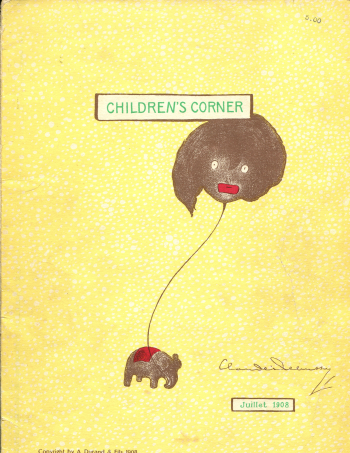Looking at the somewhat sparse blog postings lately, it looks like I’m just plowing through For Bunita Marcus and not much else. Not true! Let me take a moment to touch on a few other things that I’m playing and thinking about:
Debussy and racism
I found my copy of Debussy’s Children’s corner, purchased in 1970, with its bright yellow cover (above). That cover always disturbed me with its grotesque, disembodied grinning black face. At the time I learned Snow is dancing and none of the other pieces. Lately I’ve been enjoying playing through all of them, especially the poignant Little shepherd, the Satie-like Jimbos lullabye, and, of course, Golliwog’s cakewalk. Frances & I got into a discussion about what a Golliwog is, and I turned to the Internet, where I found an extensive entry from The Jim Crow Museum of Racist Memorabilia. I had no idea that this was behind the piece, although that grinning face on the cover should have tipped me off. What to do? The racist origin of the thing taints my experience of it now, but I have other associations with it that transcend that. Does that redeem it, purify it in some way? I have no answers, but there could be a much longer post in all of this.
Learning to be Gershwin
George Gershwin made solo piano arrangements of a number of his favorite songs. I love the Gershwin songbook, and so I bought the score and have started learning some. They are a challenge, which is something I was looking for. It’s clear to me that these are snapshots of Gershwin himself just sitting down to the piano and riffing on his own tunes. The style and some of the mechanics of the playing are quite different from what I’m used to, which makes them more difficult to learn. It’s not just learning the notes, it’s learning the whole style, learning new mechanical and musical habits; learning, in a way, to be Gershwin. My favorites so far? The luxurious “Do it again” and the “Who cares?” (one of my all-time favorite Gershwin songs), with its quirky rhythmic accompaniment.
Flute music
I’ve always loved the Poulenc flute sonata. As an undergraduate I actively sought out a flutist with whom to play it (not the usual path for an “accompanying” gig). Now that I have a piano again, I’ve done it again. Our good friend Elizabeth Brown loaned me her score and we played through the sonata the last time she came over for a visit. I held my own on the first two movements but massacred the third. But it was fun, and it was great to having a sonic companion for the piano in the house. Elizabeth brought over a bunch of other scores for us to consider. I haven’t started playing through these yet, but there are pieces by Bartok and Schumann that have attracted my attention.
Schumann (& Feldman?)
And speaking of Schumann, one of my goals for the year was to learn more of his music. I have my heart set on learning Carnaval, but that will take lots of time and attention, and I’m using that on Feldman at the moment. So to tide me over until then, I’ve been learning the Blumenstück, Op. 19. Maybe it’s just me and the musical place I’m in these days, but the piece keeps reminding me of Feldman. It has an open-ended, repetitive structure built of low-contrast materials. The effect is disorienting: you can’t remember where you’ve been before and how you got here. Everything seems somehow related, but you can’t quite place it, at least not consciously. For example, when I started working on the score, I was surprised to find that the opening section is never repeated; I somehow assumed that it was the thing that came back over and over, but in fact it’s the second thing that does that (Schumann loves to bring back the second thing, as in the Davidsbündler or Dichterliebe). In any event, a nice complement to the Feldman.

